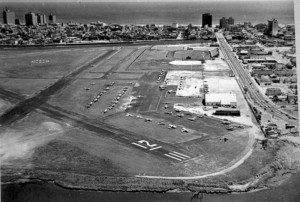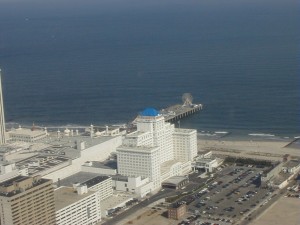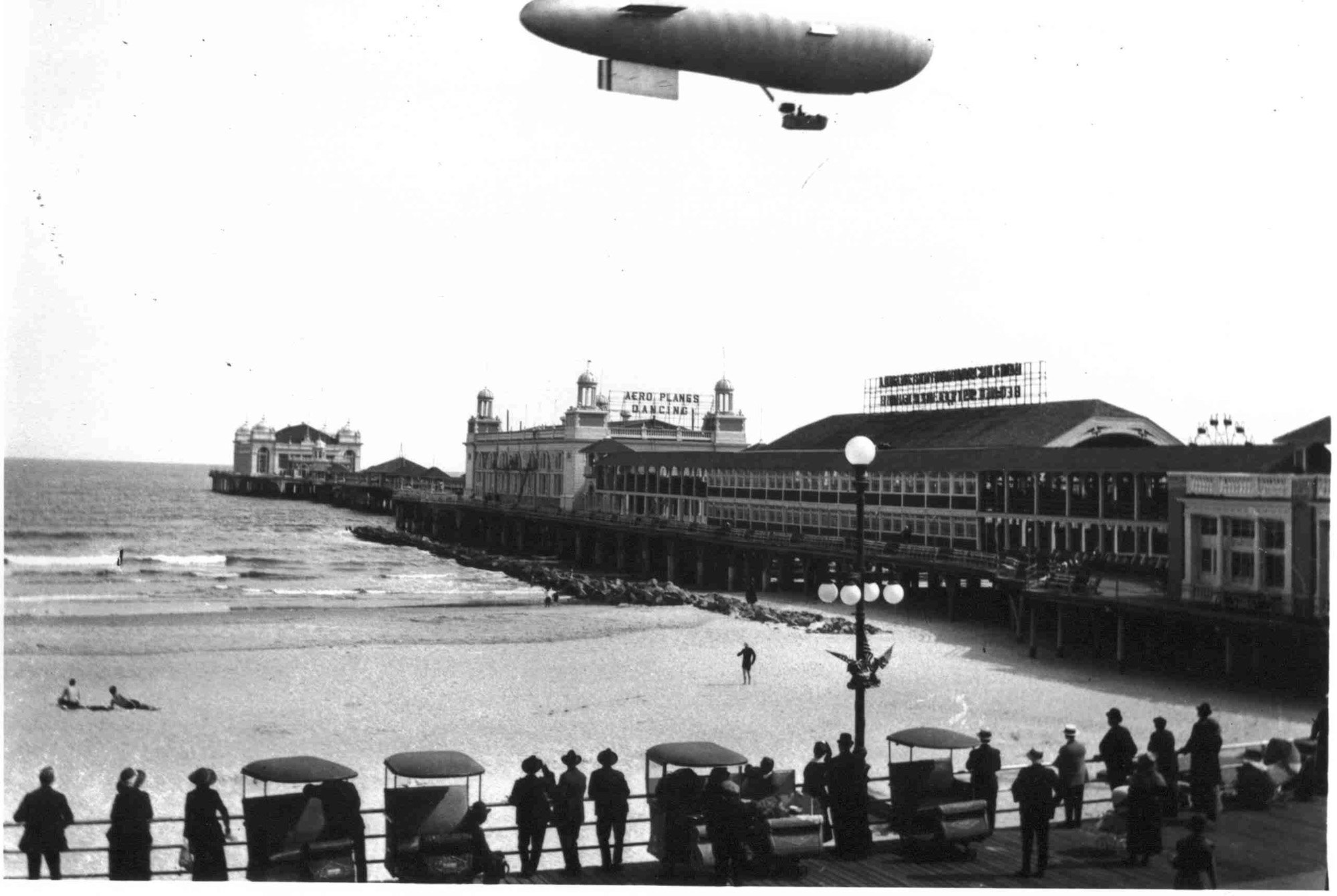By Henry M. Holden

The vacation resort and emerging aeronautical activities drew people to Atlantic City. Over the Steel Pier is what appears to be an open gondola dirigible.
After 86 years of operation, Atlantic City Municipal Airport/Bader Field (AIY), in Atlantic City, N.J., closed on September 30. Local pilots and the Aircraft Owners and Pilots Association waged a long battle against three successive Atlantic City administrations. But the development interests were stronger than the aviation interests.
Licensed since 1911 as a portal for passenger transport, Bader Field was one of the oldest general aviation fields in the United States. The term “airport” was coined there in 1919, and it was the first municipal airport in the U.S. for both land and seaplanes. The Civil Air Patrol was founded at Bader Field in 1941, a week before the Japanese bombed Pearl Harbor.
On July 8, 1922, Atlantic City purchased the airport from a private owner. Its size remained unchanged for many years; an inland waterway encroaching on three sides and a state highway prevented expansion. In its early years, the land didn’t have the runway configuration of today. Edward L. Bader, the city’s mayor, constructed athletic fields on the south corner.

The earliest known photo of Bader Field shows the near completion of a third hangar. The circle in midfield is believed to have been a dirigible mooring area.
Over the years, runways, taxiways, a control tower and hangars were built. A shortwave radio and lights were installed. Along with many airport improvements, a minor league baseball stadium opened at Bader Field on Oct. 22, 1949.
Allegheny Airlines was the last of the major commercial carriers to fly in and out of Bader Field. In October 1978, Allegheny pulled out of Bader, announcing daily flights between Atlantic City International Airport (ACY), about 15 miles west of Bader Field, and New York City. Commercial air traffic at Bader Field was nearly gone by the mid-1980s, as the South Jersey Transportation Authority began pumping millions of federal and state dollars into ACY. With the end of scheduled flights out of Bader Field, the slow, agonizing and piecemeal death of the airport began.
By the late 1990s, Bader Field’s control tower, fuel tanks, terminal and repair facilities were gone. Mechanical problems had to be handled by a mechanic from a nearby airport. ACY quickly became the airport of choice. Pilots—especially those flying plush, private jets to transport high rollers to the casinos—aimed for the state-of-the-art airport, and eschewed the steep descents, erratic off-shore winds and narrow 100-foot-wide runways at Bader Field.

This photo was taken during World War II, when the Navy used Bader Field. It’s unclear what had happened to the runways, but they were later restored.
In 1986, Atlantic City agreed to accept federal funds under a Federal Aviation Administration grant assurance agreement. The agreement came with a contractual obligation to operate the airport for 20 years, or in perpetuity, if Atlantic City used the grant to buy land.
Since the city didn’t purchase land with the funds, the contract expired in September 2006. Atlantic City was free to do as it pleased with the land. At approximately 140 acres, and within a short distance of boardwalk casinos, the land will probably be redeveloped.
In the early 1990s, Atlantic City Mayor James Whelan went to U.S. Senator Frank Lautenberg (D-NJ) and convinced him to introduce a rider on a bill that would remove the grant obligation from Atlantic City. Lautenberg wanted Bader Field closed. Some say he used his position in an attempt to compromise the FAA’s authority over public use airports. He said the airport was unsafe, and joined forces with Whelan, who lives close to the Bader Field property line.
That rider, attached to a Senate transportation appropriations bill, would have effectively allowed the FAA to release Atlantic City from the agreement that protects the FAA’s investment in publicly owned public use airports. That would have opened the door to shut down Bader, but the bill failed to get out of committee. (A similar tactic was used successfully on a California airport last year.)

This photo, taken sometime before the 1970s, shows more than four dozen aircraft tied down. At some point, the runways were resurveyed; because of a magnetic shift, Runway 12 became Runway 11.
In the mid-1990s, with Whelan’s approval, construction of a new baseball field began at the airport. The FAA became aware of this only after the groundbreaking. The grant assurance agreement covered the entire property. The FAA ruled the stadium wasn’t a compatible use and was about to order the city to tear it down. If that had happened, the city probably would have stopped all maintenance of the property, and the FAA would have shut the field down. In a quid pro quo for the city, the FAA compromised and told the city to continue with stadium plans, but not to build anything else that wasn’t compatible with general aviation.
The stadium construction in 1996 prompted a memorandum of understanding between Atlantic City, the state of New Jersey and the FAA. Atlantic City agreed to maintain the airport and its approaches, to return the fire station to airport use, and to replace ripped up ramp and tie down areas.
Airport maintenance was a problem for the city. Seagulls routinely dropped clam shells on the runways and taxiways, to crack them open, and the city had to routinely sweep down the macadam. The fixed base operator suggested painting seagulls in flight on the runways and taxiways to discourage the seagulls.

This photo, taken in 2000, shows only a handful of resident airplanes. Water surrounds the field on three sides. The highway behind the stadium, Albany Avenue, is the only land connection to the field.
Other provisions of the agreement provided funding for airport operations and maintenance from fair market ground rent for the property underlying the stadium. The agreement provided an FBO to operate the airport. The presence of an FBO for the Unicom minimized weather-related problems, along with an automated weather station on the field. Proper reporting of wind velocity and direction alerted transient pilots to hazardous conditions. In return, the city could proceed with constructing a baseball stadium on part of the airport property.
In 1998, near Runway 29/11, the Sandcastle Stadium opened for business. The $14.5 million, 5,900-seat minor league baseball stadium was renamed Bennie Robbins Stadium in 2006.
Those who are familiar with Bader Field believe that the only thing wrong with the airport is Atlantic City’s consistent mismanagement over the decades. In 2000, the FAA cited the city for the poor repair of the runways and taxiways. By 2006, less than a dozen based aircraft remained.

Steel Pier is constantly changing in this resort city. In the past six years, new buildings have arisen around the pier.
The city tore down the brick terminal that had served the commuters, and replaced it with a portable trailer. The city had neglected the airport for years, and that drove away aircraft and aviation businesses. And as more pilots and aircraft were driven away, it became increasingly harder to generate any kind of political support for the airport on both the local and national level.
What could have been
Bader could have been an attraction for thousands of pilots who live within a few hours’ flight of the resort city. The Atlantic City administration actively discouraged traffic at Bader Field by letting it fall into disrepair, even though it attracted 100,000 visitors a year, who spent millions of dollars annually.
Traffic at Bader increased for awhile when a grass-roots effort got out the word that the airport was still open for business. On any given fair-weather weekend, hundreds of aircraft operations occurred, mostly due to the word-of-mouth promotion.

Departure from Runway 11 allows the pilot and passengers an up close view of the often unseen contrast between posh hotels and ordinary homes.
Bader is located in one of the fastest growing urban regions of New Jersey. Most approaches are over water and away from populated areas. Its location on a peninsula is far enough away from residential development that it poses little hazard and aircraft noise is minimal. It’s also within a short walk of many Atlantic City casinos and attractions.
The neighbors had no problem with the airport, according to Bill Leavens, AOPA’s representative for the eastern region.
“I went down a year ago and talked with the people in Chelsea Heights, who live across from the airport,” he said. “About 85 percent said, ‘Leave the airport alone, or at least leave some part of it there.’ I proposed keeping the main runway and shortening it, so it would be usable only to single-engine general aviation aircraft, and developing the remaining acres of the property. The runway only needed about 20 acres. That way, Atlantic City could have their cake and eat it too.”
In June 2006, the city petitioned the FAA to allow closure at the end of September. Robert Levy, the press secretary for Atlantic City’s mayor, said, “We will do something (with the land) that is of the greatest benefit to the community.”
Some speculate that’s a casino or a sports arena.

The approaches to Bader Field are clearly away from populated areas. Noise was never an issue for most residents near the field.
“Atlantic City officials believed that shutting Bader would mean a win-win for them, because the sale of the airport property to private interests will generate a huge one-time infusion of cash,” said Leavens. “Thereafter, the city will receive a continuing stream of revenue from property taxes on whatever is built. Of course, the city loses 90 acres of mostly open space, an important transportation resource, and a facility that can serve first responders and emergency service personnel in the event of a public crisis.
“The immediate neighborhood wants the airport more than they want the 4,000 timeshare condos (also proposed) they’ll get once the airport is shut down. The city is the only benefactor in this. They get the dollars generated from the sale of the property (upwards of $150 million). If Steve Winn gets to put a casino there, the land may be worth considerably more.”
The New Jersey Development Rights Purchase Program Bill, introduced by Assemblyman Alex DeCroce and passed in 2003, has saved several of New Jersey’s remaining airports, but it couldn’t help Bader Field. The bill preserves an airport by allowing owners to sell their right to convert airport property to potentially more profitable non-airport uses. Owners get a portion of the airport’s potential property development value, but still continue to own and operate the airport as an airport. In return, the airport is deed restricted to remain open as a public use airport in perpetuity.
While Atlantic City owns the airport property and could sell it to the state, the asking price would probably be higher than if sold to a private owner—a price that the state couldn’t or wouldn’t meet. (The bidding for the land is now at $500 million.)
What happened at Bader Field is a wakeup call to every small airport in a downtown area. To some people, the value of the land underneath the airport is greater than the airport itself. A specter still looms in the shadows in the loophole of eminent domain. Another bill introduced by DeCroce would close that loophole and protect the remaining airports. That bill, forbidding the seizure of airport property under eminent domain, is currently stalled in committee.
The politicians only know what they hear from the voters, so it’s up to the folks in the community to speak. Bader is closed and whatever remains will be a permanent memorial to a once great and historic field.











